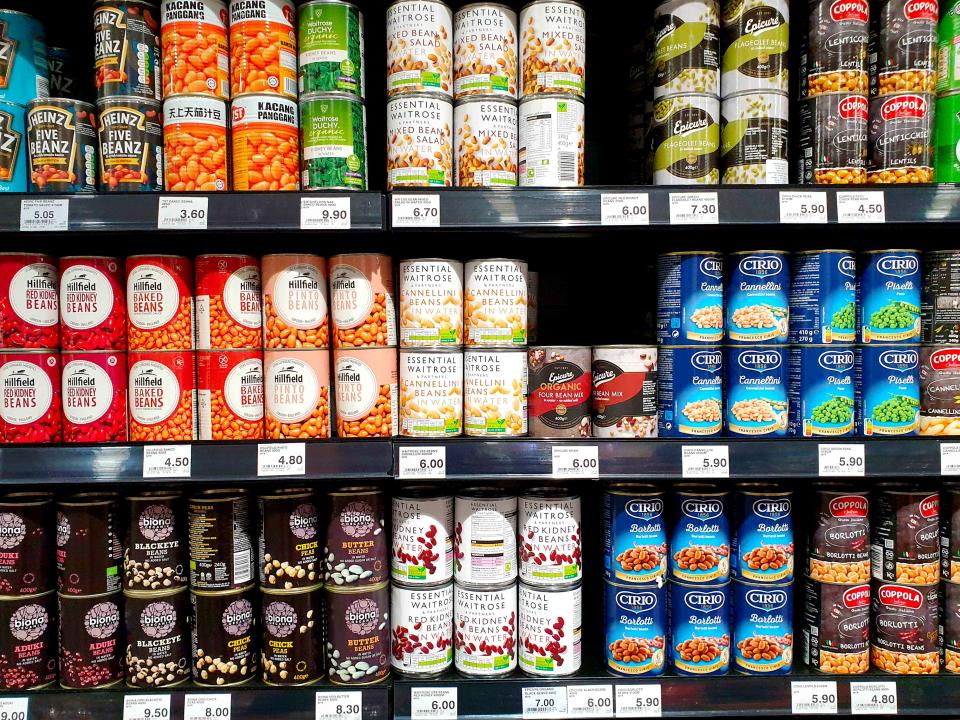The 5 Healthiest Canned Beans, According to a Dietitian
We went to a pro for a definitive list of the healthiest beans in the canned food aisle. Meet the top five.

ltyuan/Adobe Stock
Beans are convenient: Just open the can, drain, and rinse. They’re also inexpensive—a big deal as grocery prices soar—and delicious, with so many ways to prepare them across courses and cuisines, from black bean and corn quesadillas to skillet gnocchi with chard and white beans and cauliflower and chickpea tacos. As if these shining qualities aren’t enough, a single can of beans is also loaded with nutritional value.
“Beans have numerous health benefits including being a great source of fiber, iron, potassium, magnesium, and folate,” says Nicki Parlitsis, MS, RD, a functional registered dietitian at Michelle Shapiro Nutrition LLC in New York. “While all types offer a healthful addition to any meal, some may pack more punch than others,” she says.
Here is Parlitsis’ ranking of the best of the best when it comes to beans:

1. Adzuki Beans
Also known as red mung beans, adzuki beans are prized for their sweet, nutty flavor; they are commonly mashed into a paste and used in Asian sweets like cakes, pastries, and even ice cream. While you’ll often find them dried, you can buy them canned as well. And as for their health prowess, “Adzuki beans rank highest in potassium and zinc, providing 35% and 27% of the daily value of each nutrient, respectively,” Parlitsis says. Potassium is particularly important, because it “is essential to balancing out sodium in our diets, and many Americans skew sodium-heavy in this balance,” she says. “Zinc is a vital nutrient, especially for vegans and vegetarians, that plays a big role in DNA synthesis, immune function, and cell signaling.” Adzuki beans also boast a hefty amount of protein and fiber–17 grams of each–per cup.
The Best Ways to Use Them: Try adzuki beans in vegetable dishes, vegetarian kabobs, red bean ice cream, curries, soups, and stews.

2. Soybeans
While soybeans are often sold dried or frozen (in the case of edamame), black soybeans are available in cans in many stores and online. “Soybeans provide the most protein, calcium, and magnesium compared to other types of beans,” Parlitsis says. “At almost 30 grams of protein per cup, soybeans are your best choice when it comes to using beans as a main protein source.” Soybeans also provide the most magnesium at 37% of your daily need per cup. Magnesium is required for more than 300 processes in the body, including muscle contraction, blood sugar control, bone health, and blood pressure regulation. “Consuming whole-food, minimally processed soybeans has been associated with improved blood cholesterol levels, reduced breast cancer risk, reduced inflammation, and lower risk of cardiovascular issues,” says Parlitsis.
The Best Ways to Use Them: Try soybeans in salads, salsas, soups, with rice, and in place of chickpeas when making hummus. For even greater benefits, Parlitsis recommends enjoying fermented soy such as tempeh, miso, and natto. “The fermentation process increases the bioavailability of many nutrients, which means the body can more readily absorb and utilize these beneficial vitamins and minerals.”

3. Chickpeas
Whether you call them chickpeas or garbanzo beans, these nutritional powerhouses “provide 71% of the daily value for folate, a B-vitamin that is essential for DNA synthesis, red blood cell formation, healthy cell growth, and is especially critical during pregnancy to reduce birth defects,” Parlitsis says. Chickpeas also provide 17% of your daily zinc needs, second only to Adzuki beans.
The Best Ways to Use Them: Chickpeas make for a great snack when roasted with savory spices, a crowd-pleasing appetizer when blended into hummus, a delicious vegetarian sandwich when fried into falafel, and an easy protein boost when tossed atop a green salad.

4. Navy Beans
While all beans are great sources of fiber, navy beans lead the pack with 19 grams per cup—more than half of the amount recommended per day. “Eating enough fiber improves digestive health, cholesterol levels, blood sugar, and keeps you full,” Parlitsis says. Navy beans are also rich in calcium, with 1 cup providing 13% of the daily recommended value. “Calcium is an important nutrient for bone, nerve, and heart health, and consuming adequate amounts has been associated with a lower risk of colon cancer,” Parlitsis says.
The Best Ways to Use Them: A hearty navy bean soup, warming white chicken chili, and even a smooth French onion dip with a navy bean base are delicious ways to utilize the can in your pantry. Get even more navy bean recipes here.

5. Black Beans
Black beans boast high levels of magnesium and folate, two essential nutrients. “Compared to other beans, regular consumption of black beans has been associated with improved vascular health (think: arteries and veins) and cholesterol levels,” Parlitsis says. If you like to pair your black beans with rice, you’re already making a healthy choice. “Consuming rice with black beans improves insulin sensitivity and blood sugar control compared to eating rice alone,” Parlitsis says. “The protein and fiber content of the beans helps to slow down the digestion and absorption of the rice starch into our bloodstream.”
The Best Ways to Use Them: Whether it’s a homemade black bean veggie burger, black bean salsa, or a casserole dish brimming with black bean and sweet potato enchiladas, there are nearly endless ways to put a can of these hearty beans to use. Here are 16 more delicious ways to cook with a can of black beans.
The Canned Bean Bottom Line
“Every can of bean provides fiber and other beneficial nutrients, so adding any type to your diet is a great start,” Parlitsis says. Each has a different flavor and texture, so the canned food aisle is your friend when it comes to playing with recipes and cuisines–and eating healthy.

